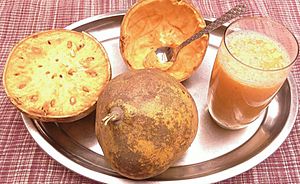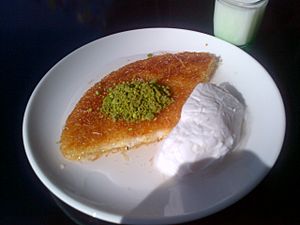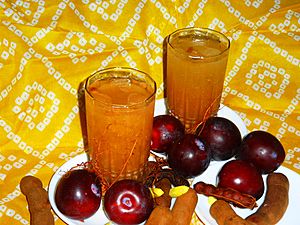Sharbat (beverage) facts for kids
Sharbat is a sweet, cool drink made from fruit or flower petals. It's like a concentrated syrup that you can mix with water to make a refreshing beverage. People usually serve it chilled.
Many popular sharbats are made from ingredients like basil seeds, rose water, fresh rose petals, sandalwood, lemon, orange, mango, pineapple, grape, and chia seeds.
Sharbat is a common drink in homes across countries like Iran, Turkey, Bosnia, Afghanistan, Pakistan, Bangladesh, and India. It's especially popular among Muslims who drink it to break their daily fast during the month of Ramadan.
In South India, a similar drink called sarbbath is popular. It's often made with a special syrup from Indian sarsaparilla and lemon, mixed into milk or soda water.
Indonesia also has a drink called serbat, which is often enjoyed during Ramadan. A popular type is serbat blewah, made by mixing cold water, syrup, and shredded cantaloupe.
Contents
What's in a Name?

The word sharbat comes from the Persian word sharbat, which means "a drink of sugar and water." This word originally came from the Arabic word shariba, meaning "to drink."
Over time, in the Middle Ages, the Arabic word sharāb started to mean "alcoholic drink." So, other forms like sharbāt in Arabic, and sharbat in Persian and şerbet in Turkish, began to mean a sweet, non-alcoholic drink.
A Sweet History
Sharbat is believed to have first been made in Iran (which was once called Persia). Old books from the 11th and 12th centuries, like the Canon of Medicine and Zakhireye Khwarazmshahi, mention different types of sharbats.
When Europeans first learned about sharbat, they heard about it from the Ottoman Turks. The Italian word sorbetto came from şerbet, and then it became sorbet in French. In the 1600s, England started importing "sherbet powders" made from dried fruit, flowers, and sugar. Today, sherbet powder is still popular in the UK.
Long ago, sharbat was often made with cane juice. But now, it's usually made at home with sugar and water. Sometimes, lime is added for better taste. Honey is also a common sweetener. Sharbat comes in many flavors, including lemon, pomegranate, cherry, orange, and rose.
Sharbat in India
The Mughal rulers brought sharbat to India in the 1500s. One ruler, Babur, loved it so much that he had ice brought all the way from the Himalayas just to make cool, refreshing sharbat!
Different Kinds of Sharbat
Many different kinds of sharbat exist, each with its own special taste.
- Tamarind Sharbat: This is a popular non-alcoholic drink in Muslim countries, especially during Ramadan. In Turkey, it's called demirhindi şerbeti and can be flavored with cloves, cardamom, fresh ginger, and cinnamon. In India and Pakistan, tamarind (called imli) is often mixed with dried plums (aaloo bukhara).
- Almond Sharbat: This sweet drink probably came from Persia. It can be spiced with cardamom and kewra. Some versions are made with milk and saffron, and even musk melon seeds are sometimes added.
- Wood Apple Sharbat: Known as bael ka sharbat, this is a very popular drink in India. It can be flavored with salt, pepper, and mint, or simply with sugar and lemon juice.

- Sandalwood Sharbat: Another Indian variety is made from powdered sandalwood (chandan) and sweetened milk.
- Vetiver Sharbat: Also called khus syrup, this is made from the roots of vetiver grass. It can be used to flavor milkshakes, lassi (a yogurt drink), ice cream, and other beverages.
- Rose Sharbat: This is one of the most common sharbat flavors. Rose sharbat can be used as a topping for desserts like milk pudding. In Turkey, fresh rose petals are kneaded with a little citric acid or sugar to release their amazing smell, then added to a sugar and water base.
Sharbat in the Middle East

During the Middle Ages, many Ottoman Muslims did not drink alcohol, so sharbat became very popular. Sharbat could be found in three forms: syrups (called şurup), pastes (çevirme), and tablets.
Ottoman candy makers would create strong flavors from fresh ingredients that could be mixed with water to make sharbat. Today, making sharbat is not as common, but some regions in Turkey still make the syrups. The pastes and tablets are much rarer now.
In the 1800s, a writer named Isaac Edrehi described two types of drinks: sherbet and khoshâb. He said sherbet was slightly sour and made from fresh fruit juices like lemon, quince, or cherry. Khoshâb was a sweet drink made from preserved fruits or syrups, often served at the end of meals.
An Ottoman writer named Evliya Çelebi wrote about khoshâb being a "kind of sherbet" made from the juice of many excellent fruits. He even mentioned that it was sometimes flavored with "amber and musk"! He also described shops filled with cups of sharbat made from rhubarb, roses, lemons, and grapes.
A 15th-century poem tells how the Islamic prophet Muhammad's mother was given a glass of sharbat while she was giving birth. Even today, when a woman in Anatolia (Turkey) gives birth, it's a tradition to offer a hot sharbat called lohusa şerbeti to guests.
Common sharbat flavors in the Middle East include tamarind, pomegranate, black mulberry, sour grape, and rose. A simple lemon sharbat, without extra spices, is called nişan şerbeti or "betrothal sherbet" in Turkish. It's traditionally served at engagement ceremonies. Other flavors include peach with cloves and lemon, or green apple and cinnamon.
See also
 In Spanish: Sharbat para niños
In Spanish: Sharbat para niños



